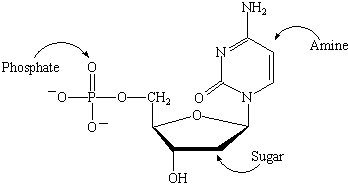
Nucleic Acids
| Nucleic Acids and Nucleotides | Classes of Nucleic Acids | Purines and Pyrimidines |
| Polynucleotides | Role of Nucleic Acids in Living Systems | |
Nucleic acids, which are relatively strong acids found in the nuclei of cells, were first isolated in 1869. The nucleic acids are polymers with molecular weights as high as 100,000,000 grams per mole. They can be broken down, or digested, to form monomers known as nucleotides. Each nucleotide contains three units: a sugar, an amine, and a phosphate, as shown in the figure below.

Nucleic acids are divided into classes on the basis of the sugar used to form the nucleotides. Ribonucleic acid (RNA) is built on a b-D-ribofuranose ring. Deoxyribonucleic acid (DNA) contains a modified ribofuranose in which the -OH group on the second carbon atom has been removed, as shown in the fiugre below.
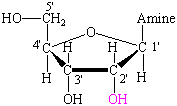 |
 |
|
| b-D-ribofuranose found in DNA | b-D-deoxyribofuranose found in DNA |
The amines that form nucleic acids fall into two
categories: purines and pyrimidines.
There are three pyrimidines ![]() cytosine, thymine, and uracil
cytosine, thymine, and uracil ![]() and
two purines
and
two purines ![]() adenine and guanine, as
shown in the figure below.
adenine and guanine, as
shown in the figure below.
 |
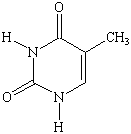 |
 |
||
| Cytosine | Thymine | Uracil | ||
| PYRIMIDINES | ||||
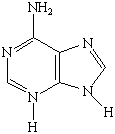 |
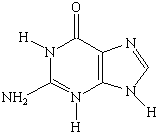 |
|||
| Adenine | Guanine | |||
| PURINES |
DNA and RNA each contain four nucleotides. Both
contain the same purines ![]() adenine and guanine
adenine and guanine ![]() and
both also contain the pyrimidine cytosine. But the fourth
nucleotide in DNA is thymine, whereas RNA uses uracil to complete
its quartet of nucleotides.
and
both also contain the pyrimidine cytosine. But the fourth
nucleotide in DNA is thymine, whereas RNA uses uracil to complete
its quartet of nucleotides.
The carbon atoms in the sugar at the center of a nucleotide are numbered from 1´ to 5´. The -OH group on the 3´ carbon of one nucleotide can react with the phosphate attached to the 5´ carbon of another to form a dinucleotide held together by phosphate ester bonds. As the chain continues to grow, it becomes a polynucleotide. A short segment of a DNA chain is shown in the figure below.

Reading from the 5´ end of this chain to the 3´ end, this DNA segment contains the following sequence of amine substituents: adenine (A), cytosine (C), guanine (G), and thymine (T).
Role of Nucleic Acids in Living Systems
For many years, the role of nucleic acids in living systems
was unknown. In 1944 Oswald Avery presented evidence that nucleic
acids were involved in the storage and transfer of the genetic
information needed for the synthesis of proteins. This suggestion
was actively opposed by many of his contemporaries, who believed
that the structure of the nucleic acids was too regular ![]() and therefore too dull
and therefore too dull![]() to carry the
information that codes for the thousands of different proteins a
cell needs to survive.
to carry the
information that codes for the thousands of different proteins a
cell needs to survive.
In retrospect, the first clue about how nucleic acids function was obtained by Erwin Chargaff, who found that DNA always contains the same amounts of certain pairs of bases. There is always just as much adenine as thymine, for example, and just as much guanine as cytosine.
In 1954, James Watson and Francis Crick proposed a structure for DNA that explained how DNA could be used to store genetic information. Their structure consisted of two polynucleotide chains running in opposite directions that were linked by hydrogen bonds between a specific purine (A or G) on one strand and a specific pyrimidine (C or T) on the other, as shown in the figure below. These strands form a helix that is not quite as tightly coiled as the a-helix Pauling and Corey proposed for proteins.

This structure must be able to explain two processes. There must be some way to make perfect copies of the DNA that can be handed down to future generations (replication). There also must be some way to decode the information on the DNA chain (transcription) and translate this information into a sequence of amino acids in a protein (translation).
Replication is easy to understand. According to Watson and Crick, an adenine on one strand of DNA is always paired with a guanine on the other, and a cytosine is always paired with a thymine. The two strands of DNA therefore complement each other perfectly; the sequence of nucleotides on one strand can always be predicted from the sequence on the other. Replication occurs when the two strands of the parent DNA molecule separate and both strands are copied simultaneously. Thus, one strand from the parent DNA is present in each of the daughter molecules produced when a cell divides.